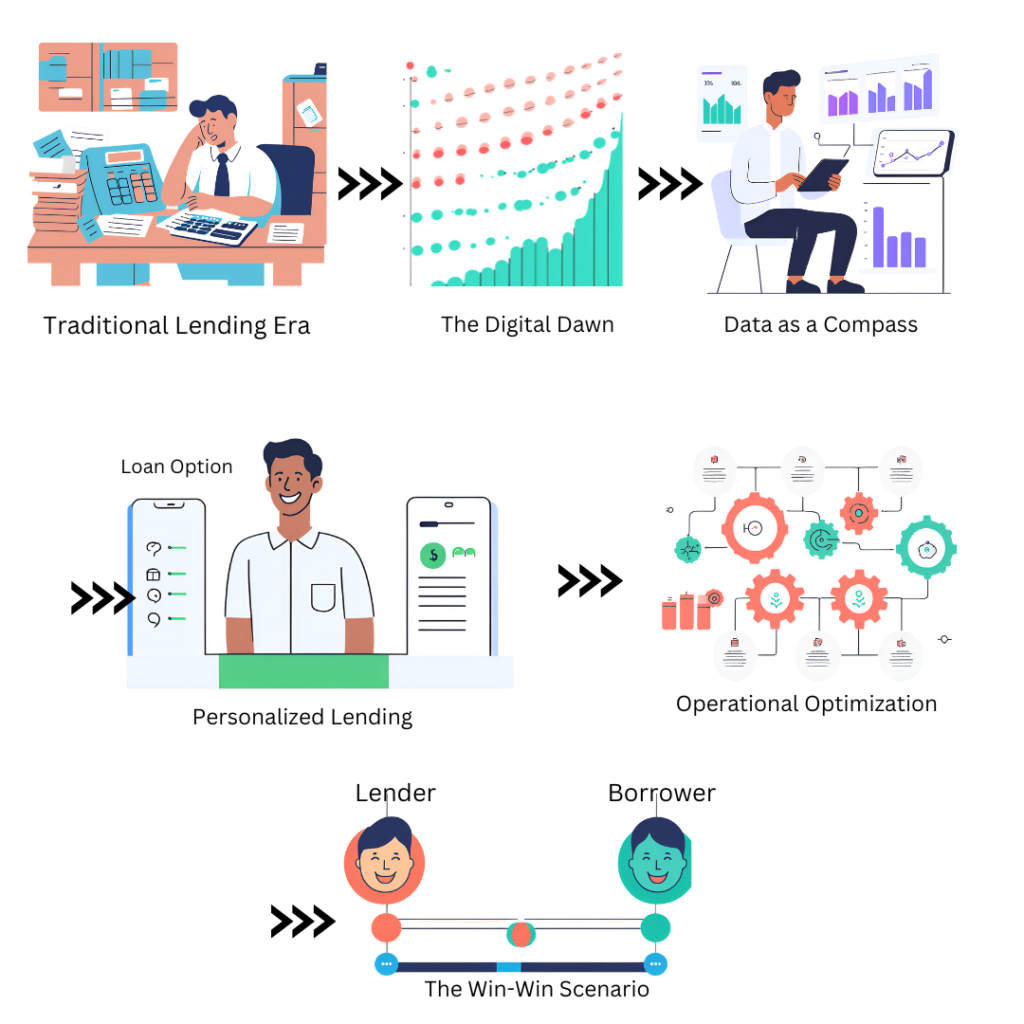In the past, lending decisions relied on limited data and human intuition. Today, the landscape has transformed dramatically. Lenders now have access to a wealth of information, from traditional credit scores to alternative data sources. By harnessing the power of analytics, financial institutions can make more informed, data-driven decisions that mitigate risk, enhance customer experience, and drive profitability. Through advanced modeling and data-driven insights, lenders can refine credit risk assessment, personalize customer journeys, and optimize pricing strategies. By uncovering hidden patterns and trends, financial institutions can identify new opportunities, reduce costs, and improve profitability.
Why is Analytics Crucial in Fintech Lending?
Once upon a time, lending was a world of hunches and spreadsheets. Lenders relied on gut feelings and limited data to make crucial decisions. But then, a digital dawn emerged, and fintech brought a treasure trove of data.
Imagine a vast ocean of information brimming with insights about potential borrowers. This is the world fintech lenders navigate today. With data as their compass, they have transformed lending from an art to a science. Advanced algorithms sift through mountains of information, uncovering patterns and predicting behaviors, allowing lenders to identify borrowers more likely to repay, thus reducing defaults and bad debts.

Illustration of lending from traditional methods to data-driven fintech solutions.
Data also unlocks personalized experiences. By understanding a borrower’s financial journey, lenders can tailor offers to individual needs. Whether a quick loan for a medical emergency or a plan to consolidate high-interest debts, data-driven insights make the process faster and more accurate.
Furthermore, data empowers lenders to optimize their operations. By analyzing loan performance and customer behavior, they streamline processes, cut costs, and boost efficiency. This leads to better deals for borrowers and increased profitability for lenders.
In the end, the blend of fintech and analytics creates a win-win scenario. Borrowers receive faster, fairer, and more accessible loans, while lenders build sustainable and profitable businesses. It’s a financial fairytale where data is the magic wand, transforming lending into a force for good.
Analytics empowers lenders to:
- Make data-driven decisions: Analyze vast amounts of data, lenders can gain valuable insights to inform strategic choices.
- Enhance risk management: Use sophisticated models to identify potential risks, reducing loan defaults and protecting the lender’s portfolio.
- Optimize customer experience: Understand customer behavior to tailor products and services to individual needs.
- Increase operational efficiency: Automate processes and streamline workflows, leading to cost reductions and improved productivity.
- Drive revenue growth: Identify new market opportunities and optimize pricing strategies to boost profitability.
Data Analytics Usecases in Lending
Lending analytics encompasses many applications that drive value for financial institutions. Key areas of focus include:
| Underwriting and Risk Assessment | Build sophisticated credit models using data. Accurately assess borrower creditworthiness. Reduce loan defaults with predictive analytics. Incorporate alternative data sources for comprehensive risk assessment. |
| Customer Profiling and Segmentation | Create detailed profiles based on demographics, behavior, and preferences. Identify target customer segments for personalized marketing campaigns. Enhance satisfaction with tailored product offerings. Improve customer lifetime value by understanding needs. |
| Loan Monitoring and Portfolio Management | Track key performance indicators (KPIs) to assess loan performance. Identify early warning signs of delinquency and default. Optimize portfolio composition and asset allocation. Implement effective collection strategies. |
| Fraud Detection and Prevention | Use advanced analytics to detect fraudulent activities. Build robust fraud prevention models. Protect the lender’s reputation and financial assets. Stay ahead of evolving fraud tactics. |
Challenges of Traditional Lending Practices and Analytical Solutions to Overcome
While analytics offers substantial benefits, implementing a successful analytics strategy requires addressing key challenges and their solutions.
1. Data Silos and Integration Challenges
- Challenge- Lenders often grapple with disparate data sources that are fragmented and incompatible. This data siloing hinders the creation of a unified view of borrowers, market dynamics, and portfolio health. As a result, decision-making becomes complex and potentially hindered by incomplete or inaccurate information.
- Solution-Data Consolidation: Combining data from various sources (credit bureaus, banks, etc.) into a unified view. This improves data accessibility and accuracy for better decision-making.t tools.
2. Manual underwriting
- Challenge-This involves human judgment and discretion in assessing borrowers’ creditworthiness and repayment capacity, and it can be prone to errors, biases, and fraud.
- Solution-Automated Underwriting: Leveraging AI and machine learning to expedite loan approvals. Reduces manual effort and errors.
3. Rigid Pricing and Policy Limitations
- Challenge-Traditional lending often relies on inflexible pricing and policies, hindering adaptation to varying borrower profiles and market fluctuations. This can lead to missed opportunities, revenue loss, and customer dissatisfaction.
- Solution: Dynamic Pricing: Tailoring loan terms to individual borrowers based on real-time data. Optimizes returns for lenders and benefits customers through personalized offerings.
Conclusion
The transformative potential of analytics in the lending industry cannot be overstated. By harnessing the power of data-driven insights, lenders can make informed decisions, enhance customer experiences, and gain a competitive edge in an evolving marketplace. Lending firms can maximize the benefits of predictive analytics by aligning business goals with analytical outcomes, selecting the right analytical partners and tools, and leveraging data visualization capabilities.
With several years of experience in the lending domain, Insight Consultants offers a robust, user-friendly solution that enables informed decision-making through accurate predictions and easy-to-build decision models.
Contact us if you are looking for ways to harness the power of data analytics.







